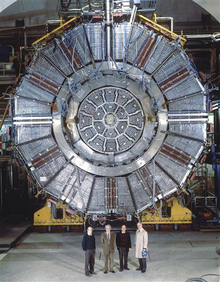ALEPH (detector)
The ALEPH detector was one of four detectors at the LEP - storage ring of CERN , which collected data from 1989 to 2000. The name is an acronym for " A pparatus for LE P Ph ysics". The aim of the experiment was to study the Standard Model and to search for features of unknown new physics beyond the Standard Model.
construction
As with most large detectors, the structure is arranged around the collision point in the shape of an onion skin in scattering experiments. A distinction can be made between three areas:
- Tracking
- Calorimetry
- Muon measurement
The tracking system has the task of measuring the traces of the particles and, if necessary, making statements about the type of particle possible. The innermost shell is used to measure the location as precisely as possible with the aid of silicon semiconductor elements in the form of a so-called vertex detector . The drift chamber attached around it (called Inner Track Chamber , ITC at ALEPH ) now allows not only track recording in the r-φ plane, but also momentum measurement and thus a possibility to determine the type of particle. The last element of the track measurement is another drift chamber ( Time Projection Chamber , TPC), which records 3 coordinates and contributes to the particle identification via the energy loss of the particle within the chamber.
The calorimeter system includes the electromagnetic and the hadronic calorimeter. Depending on the type of particles produced, one or both calorimeters measure the energy.
Muon detection takes place in the outermost shell, since muons are generally the only particles that can pass through all detectors.
